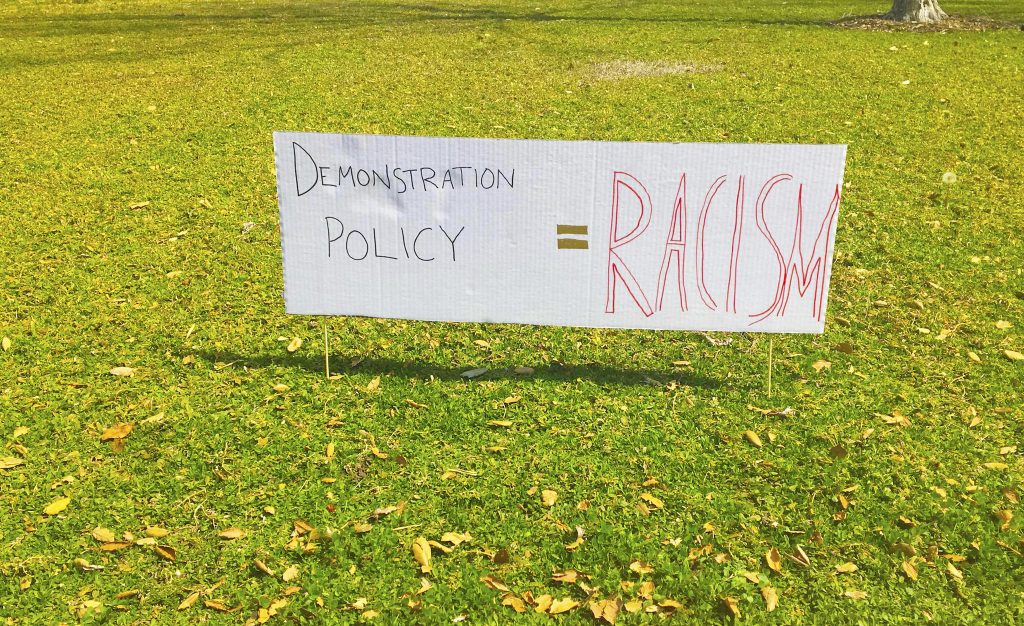By Elizabeth Willsmore
Walking across the lawn in front of the President’s House, the scene looked like any other you might find at Scripps during lunch. The air was filled with the soft, feminine trills of a hipster Spotify playlist, bunches of roses lay scattered across the pathway between Revelle House and Humanities, and Scrippsies in floral skirts mulled around the premise, eating lunch and enjoying each other’s company. In fact, it took most onlookers a few seconds to notice the yellow caution tape blocking off all entrances and exits to the pathway, the signs placed on the president’s lawn reading “More than just Bias” and “Demonstration Policy = Racism,” and the large chalk letters reading “End Discrimination Bias” framing the president’s driveway.
Each element of this action, titled “Roses and Racial Bias,” was the same as one of the rules broken in the demonstration policy during the Heather MacDonald protests last April, after which Claremont McKenna College suspended five students for blocking pathways to the Athenaeum. In the wake of these suspensions, students across the 5Cs called out the demonstration policy’s racism in its implantation of punishment – a critique the “Roses and Racial Bias” action was organized to highlight. Their mission statement asserts that “the colleges disproportionately utilize the 7C demonstration policy in a way that is raced, classed, and ultimately aims to protect notions of ‘freedom of speech’ as neutral to protect their own philosophy. We, Scripps femmes, majority of whom are white, protest this.”
This assertion speaks to a national issue surrounding students’ right to protest, and how colleges’ responses to direct action are often rooted in institutional racism. For instance, four of the five Claremont colleges have issued statements saying current high school seniors who protest school shootings will not be penalized in their admissions decisions, whereas no institution extended the same leniency to students protesting police brutality in the wake of the murders of Trayvon Martin and Michael Brown. Especially at institutions like Scripps, whose very founding was exclusively rooted in heteronormative white feminism, calling out institutional racism and bias is imperative to highlighting the explicit, physical ways in which colleges discriminate and denigrate student activism, especially around issues of race.
To replicate the rules broken at the CMC protests last year, organizers of the “Roses and Racial Bias” action used yellow caution tape to block entrances to the pathway between Humanities and Revelle House, placed flowers around the roped off area to illustrate destruction of property, placed signs about institutional racism and bias on the president’s lawn, and wrote on the pathways in chalk in violation of the rule in “Guides to Student Life.”
Ana Paz (SCR ’20) told the Voice that grounds staff helped the students set up by providing the caution tape and by not shutting it down, thereby standing in solidarity with the need for change in the demonstration policy.
Other organizers of “Roses and Racial Bias” all stated that they didn’t expect any repercussions for this action. Paz commented that this expected lack of response by the Scripps administration was a goal of the demonstration as a “testament to how much leniency the institution actually has,” as well as to “see the limits of what institutions consider threatening or dangerous.”
The swift decisiveness with which CMC suspended and punished students for protesting a talk that promoted anti-blackness illustrates the underlying racial bias in the 7C demonstration policy – and the lack of response by Scripps College to the “Roses and Racial Bias” action, for which the same rules were broken, emphasizes that it is not direct-action colleges find fault with, but rather, what kind of direct action.
One of the organizers, Sophie Peters (SCR ’20) said “as an organizer I point out the hypocrisy in the demonstration policy as it is right now.”
The contrasting responses to these two protests emphasizes what many at the Claremont Colleges already know: that the 7C demonstration policy criminalizes protests surrounding Black Lives Matter and other race-based discrimination, while protecting those actions which are majority white.
Essentially, the “Roses and Racial Bias” demonstration accomplished exactly what the organizers set out to do – by breaking the same rules as at the Heather MacDonald protest, but through a white, hyper feminized lens, organizers ensured that Scripps would not retaliate or punish those involved – thus exemplifying in an explicit manner the institutional racism in the 7C demonstration policy. The organizers stated that this demonstration is the first in a series that will be conducted at each of the 5Cs, which are meant to illustrate how exactly each college will utilize the policy to “dole out punishment to its own students.”



